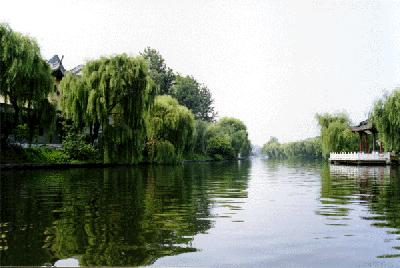 The Slender West Lake is situated in the northwest suburb of Yangzhou City in Jiangsu Province. Originally a natural river course, the lake gradually became a scenic area following continuous harnessing through the dynasties. The beauty of the Slender West Lake lies in the meandering lake and simple and unsophisticated constructions. Touring along the lake on a boat, one is fascinated by the changing scenery. Main sights on the lake include the Spring Willows Along the Long Causeway, the Xuyuan Garden, Plum Hill in Late Spring, Yueguan, Chuitai, Clouds Flowing over the Water, the White Pagoda, and the Five Pavilion Bridge, etc.
The Slender West Lake is situated in the northwest suburb of Yangzhou City in Jiangsu Province. Originally a natural river course, the lake gradually became a scenic area following continuous harnessing through the dynasties. The beauty of the Slender West Lake lies in the meandering lake and simple and unsophisticated constructions. Touring along the lake on a boat, one is fascinated by the changing scenery. Main sights on the lake include the Spring Willows Along the Long Causeway, the Xuyuan Garden, Plum Hill in Late Spring, Yueguan, Chuitai, Clouds Flowing over the Water, the White Pagoda, and the Five Pavilion Bridge, etc.
The Slender West Lake is 4.3 kilometers in total length with an area of over 30 hectares. The Long Causeway is on the western bank of the lake, extending about one hundred meters. Weeping willows that alternate with peach trees, growing all along the causeway. Spring Willows along the Long Causeway is among the 24 Sights of Yangzhou City. At the end of the Long Causeway is the Xuyuan Garden, an ancestral temple in the old days. Lying in the garden, a limpid pool is planted fully with lotus and surrounded by various rockeries.
The Xiaojin Hill (Little Golden Hill), an islet in the lake, was built in the middle period (1644-1742) of the Qing Dynasty (1644-1911). During the Qing Dynasty, in order to open a water channel connecting the Slender West Lake and the Daming Monastery, a canal was excavated in the northwest side of the lake. The mud excavated from the river course was piled up to form a small hill that we can still see today, namely the Xiaojin Hill. A pavilion named Wind Pavilion, located at the top of the hill, is the highest spot in this scenic area.
The Five-Pavilion Bridge rests on the lake, just like a belt. It gained its name from the five pavilions built on it. Elaborate in its structure and magnificent in its decorations, this bridge has become a mark along the tour route of Yangzhou City. Built in the Qing Dynasty, it was specially designed for Emperor Qianlong′s inspection tour. The Five-Pavilion Bridge has an elegant appearance and possesses the characters of architecture in both northern China and southern China. Its yellow tiles and red columns supported by white balusters have the architectural feature in southern China while its thick piers have the architectural feature in northern China. Besides, it is also a harmonious combination of the garden architecture and bridge architecture.
Another island lying in the lake is Fuzhuang (Mallard Village), a construction built on the waterside and looking like a mallard swimming in the lake from the distant. The White Pagoda, which is an imitation of the Beihai White Pagoda in Beijing, lies south of the Five-Pavilion Bridge.
Source: http://www.chinaculture.org
 The Slender West Lake is situated in the northwest suburb of Yangzhou City in Jiangsu Province. Originally a natural river course, the lake gradually became a scenic area following continuous harnessing through the dynasties. The beauty of the Slender West Lake lies in the meandering lake and simple and unsophisticated constructions. Touring along the lake on a boat, one is fascinated by the changing scenery. Main sights on the lake include the Spring Willows Along the Long Causeway, the Xuyuan Garden, Plum Hill in Late Spring, Yueguan, Chuitai, Clouds Flowing over the Water, the White Pagoda, and the Five Pavilion Bridge, etc.
The Slender West Lake is situated in the northwest suburb of Yangzhou City in Jiangsu Province. Originally a natural river course, the lake gradually became a scenic area following continuous harnessing through the dynasties. The beauty of the Slender West Lake lies in the meandering lake and simple and unsophisticated constructions. Touring along the lake on a boat, one is fascinated by the changing scenery. Main sights on the lake include the Spring Willows Along the Long Causeway, the Xuyuan Garden, Plum Hill in Late Spring, Yueguan, Chuitai, Clouds Flowing over the Water, the White Pagoda, and the Five Pavilion Bridge, etc.